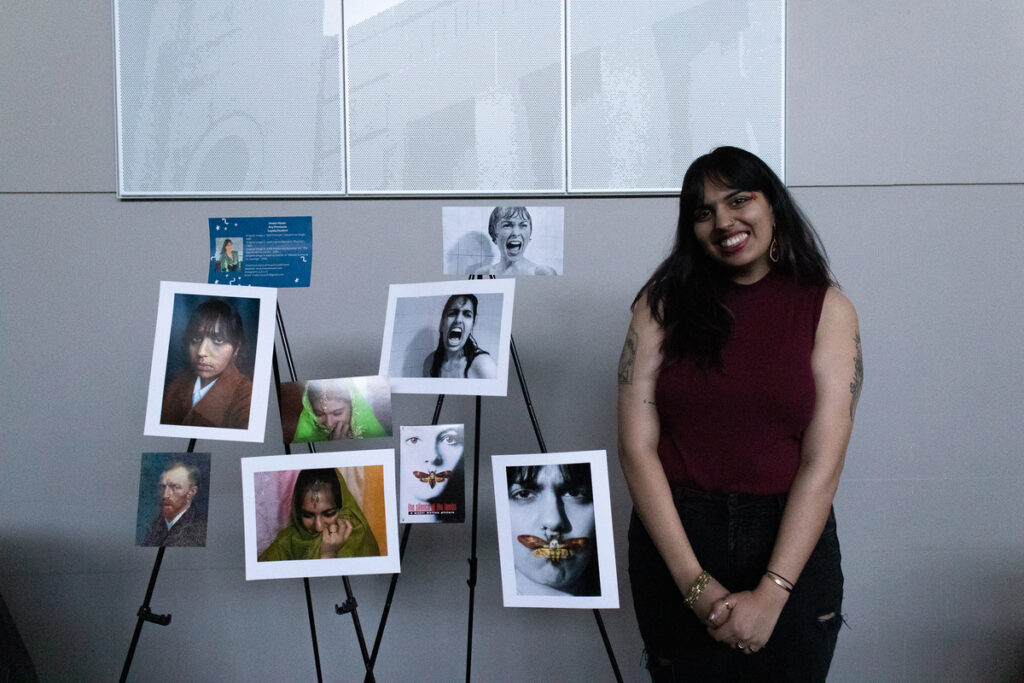Participants at the annual Loyola University Chicago Empowering Sisterhood March 21 art show all reflected on one thing — nostalgia.
Painted Personality at the LUCES Art Show
A memory of a Nicaraguan grandmother, the pains of womanhood and growing up as a queer woman.
Participants at the annual Loyola University Chicago Empowering Sisterhood art show March 21 all reflected on one thing — “They Way We Were: Nostalgia.”
The group, which includes a mentorship program, is part of the university’s Center for Diversity and Inclusion. LUCES offers a space for women and people of color — including students, staff, faculty and alumni — to share their experiences at a predominately white institution, according to their website.
The show, held in Sister Jean Dolores Schmidt, BVM Multi-Purpose Room, included a diverse array of artwork. A gallery walk lined the entryway with paintings, sketches, sculptures and photographs leading to tables lined with various foods. After being offered samosas, egg rolls and empanadas, attendees sat at violet-clothed tables awaiting live performances including spoken-word poetry and songs.
As the first of four performers, Isabella Guadamuz’s spoken-word poem titled “to my grandmother, Connie” was about her close-knit relationship with her grandmother, who lives in Nicaragua.
“I could not be half of who I am without that woman,” Guadamuz said.
Guadamuz, a third-year, said she hasn’t seen her grandmother in about eight years.
She said her time at the university wouldn’t be complete without mentioning her grandmother at least once. As a “family girl,” Guadamaz said she wanted to focus on the joyous moments with her grandmother instead of lingering on not being near her.
After her performance, the criminal justice and criminology major said a few people approached her, sharing feelings of empathy towards her poem. Even though their relationship is unique, Guadamuz said sharing her poem brought relatability.
Guadamaz said the freedom of having a space like the art show allowed her to speak freely about her experiences without fear of judgment from others.
“It’s really beautiful,” Guadamuz said. “There’s a powerful aspect of just going up.”
But the LUCES stages haven’t always been available. In past years, submissions took form in a literary journal, according to Ericka Garcia, the program coordinator for women of color initiatives.
Garcia said faculty, staff and students submitted artwork for publication but there weren’t enough pages for the diversity of the initiative. Within the last few years, LUCES transitioned from the journal to a physical space, expanding the types of art into spoken word and song.
As a Loyola alumnus, Garcia said the space is something she wishes was available while she was an undergrad at the university.

Taking advantage of the space, third-year Imaan Hasan displayed a series of self-portraits replicating famous stills that resonate with them. Hasan said each of the images is part of their past — an exploration of their identity.
Stills from “Silence of the Lambs,” “Psycho” and Bollywood films were recreated in photos alongside a recreation of Van Gogh’s self-portrait. Aside from the Bollywood photo, Hasan said they wanted to make a place for themself in the media.
“A person that looks like me wouldn’t be typically seen in these contexts,” Hasan said.
Although not part of the mentorship aspect of LUCES, Hasan said events like the art show are powerful, especially for women of color. Garcia said by focusing on women of color at a predominately white institution, students, staff and faculty can be vulnerable in their identities.
Sofia Peralta showcased her vulnerability through her spoken word performance of “When I Was Little.”
“To be a woman is to see I was baited and misled to believe in an image I cannot be,” Peralta said to the audience. “I am not the princess. I am not the maid. I am not the damsel. I am not the same as the fairy tales or the TV shows. I am not the same, I know, I know. I am simply me.”
Peralta finished her performance by ripping the poem while saying, “Life was easier before I was a woman.”
For LUCES scholar and event organizer Tiera Prince, nostalgia is a form of reclamation. Prince said sitting in memory and reflection is influential to anyone on their college journey, especially first-years.
As a woman of color, Prince said the theme offers an invitation to reflect — not only on happy memories but on stereotypes from the media and how to overcome them.
Musical artist and alumnus RayisRay performed three songs at the art show, and she said coming back to Loyola allowed her to give back in a meaningful way. Performing was a “no-brainer” for the musician, who prefers to go by her stage name.
Being able to showcase artwork in the “tumultuous” state of the world is sacred to the 24-year-old, who said art is “super sensitive and sentimental.”
For people in her life, RayisRay said she’s appreciative of their collective evolution, a common iteration throughout the night.
“Sometimes people don’t give themselves a lot of grace,” Prince said. “It’s hard to realize how much we’ve been through.”
According to Garcia, nostalgia is a way of allowing space to acknowledge vulnerability and the journey from childhood to present day.
Featured image by Leslie Meraz / The Phoenix

